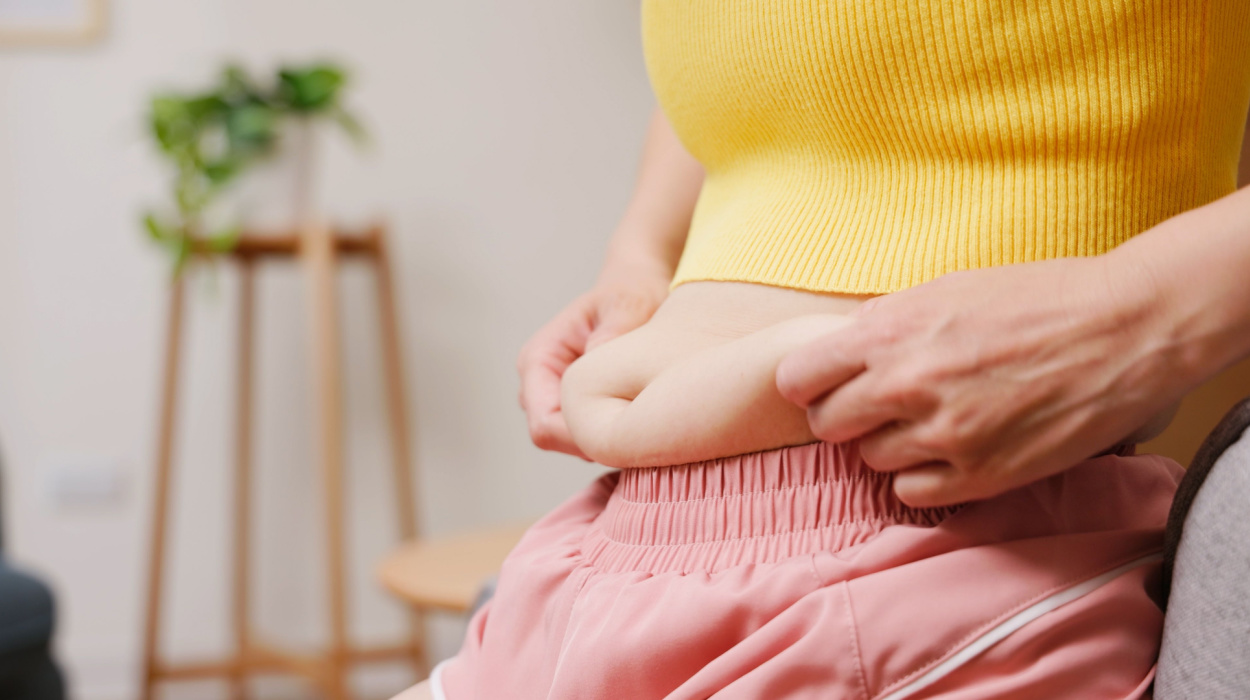You just got your tubes tied! Now that you are confident pregnancy isn’t in your future, you are finally ready to pursue healthy weight loss. But, is the challenge turning out to be trickier than expected?
During each menstrual cycle following ovulation, the egg travels down the fallopian tube. If sperm is present, this is where sperm and egg meet and fertilization occurs. Tubal ligation, colloquially called getting your “tubes tied,” is a surgical procedure that blocks the fallopian tubes.
Therefore this permanent and effective procedure[1] prevents pregnancy. However, many women experience difficulty in shedding the extra fat around their abdomen, particularly if the operation takes place immediately after giving birth.
This guide will help you understand how to lose belly fat after tubal ligation. We’ll explore if and how this form of permanent birth control impacts weight management and offer practical tips to help you on your journey to a healthier you!
How To Get Rid Of Bloating After Tubal Ligation
Ten tips for losing weight after tubal ligation:
- Take time to recover.
- Clean up your diet.
- Incorporate superfoods.
- Consider supplements.
- Practice portion control.
- Train your heart.
- Build strength.
- Plan ahead to add variety.
- Stress management.
- Prioritize quality sleep.
How To Lose Belly Fat After Tubal Ligation
Losing belly fat after tubal ligation is not all that different from any other weight loss journey. After taking care of your immediate post-surgery concerns, you want to pursue a balanced approach that combines diet, exercise, and lifestyle adjustments. Here are ten tips you don’t want to forget!
Take Time To Recover
Whether you had this procedure done during a c-section or a stand-alone operation, abdominal surgery requires plenty of time to recover. Surgery of any kind can cause swelling and inflammation, but surgery in the abdominal area can leave you bloated due to air in the abdomen or water retention.
During recovery, remember to drink plenty of water to detox your system and wait until you get your doctor’s approval before returning to normal activities. Additionally, ensure that you are consuming a nutritious and healthy diet to supplement a wide range of key ingredients that your body can use to close the wounds and grow stronger.
Clean Up Your Diet
It’s probably not news to you that it’s nearly impossible to shed belly fat without adopting a healthy diet. To get started on the right path, don’t spend all your time fixated on foods to avoid. Instead, focus on eating balanced meals with plenty of fruit and vegetables, lean protein, and whole grains, all of which are foods with plenty of fiber and protein that can help you feel fuller for longer.
Incorporate Superfoods
Fresh foods with dense nutrition and the power to detox are commonly called “superfoods.”[2] These foods include certain fruits, grains, nuts, and leafy green vegetables that provide vitamins, minerals, fiber, and other essential nutrients.
Experiment with adding different superfoods to your diet with meals such as weight-loss smoothies and colorful salads. For example, combining avocados with a Mediterranean diet has been shown to be particularly beneficial for health.[3]
Consider Supplements
No supplement or diet pill is a panacea, but nutritional deficiencies can definitely throw a wrench in your health goals. Ask your physician if certain supplements could benefit you. You may need some blood tests and special instructions if you’re breastfeeding or have a chronic medical condition.
Practice Portion Control

For many people, weight management boils down to portion control. Practice mindful eating by paying attention to hunger cues, savoring your food, and using smaller dishes. Don’t multitask, and don’t feel compelled to finish everything on your plate.
Train Your Heart
Cardiovascular activity,[4] especially moderate to high intensity, helps you control belly fat by burning more calories and optimizing your metabolism. Some of the best cardio exercises for weight loss include walking, jogging, swimming, and cycling, but any activity that boosts your heart rate counts. In general, you want to aim for at least 30 minutes of moderate-intensity cardio most days of the week, adding up to about 3 hours each week.
Build Strength
Strength training[5] helps increase muscle mass, which boosts metabolism and helps you burn fat more efficiently. There is no specific exercise that can make fat come off of a specific area of the body, and so it’s better to focus on exercising regularly with movements that target all major muscle groups.
Plan Ahead To Add Variety
Be consistent with your exercise program, eating schedule, and bedtime routine. Make sure you add variety to your workouts to challenge different muscle groups, keep your meals interesting and filling to reduce cravings for junk food, and make your bedroom a haven for rest by keeping it cool, dark, and quiet.
Stress Management

High-stress levels[6] can lead to emotional eating, metabolism changes, and increased fat storage in the belly area due to the release of cortisol. Too extreme a calorie deficit or workout can be counterproductive and stressful. Make sure you make time for stress-reducing activities like yoga, meditation, deep breathing exercises, or hobbies as you embark on your weight loss journey.
Prioritize Quality Sleep
Insufficient sleep[7] can disrupt hormones that control appetite, leading to increased hunger and potential weight gain. Aim for 7-9 hours of quality sleep[8] each night to avoid craving excess calories and to encourage effective exercise.
Does Tubal Ligation Make It Hard for You to Lose Belly Fat?
You may have heard a rumor that tubal ligation causes weight gain, but the science doesn’t bear this out. Instead, factors like aging, lifestyle changes, and postpartum or menopausal hormonal adjustments are to blame.
It’s important to consider all factors that apply when planning a weight loss strategy. By understanding the real causes behind weight gain, you can take more effective steps toward maintaining a healthy body mass and reducing hormonal belly fat.
Conclusion
Getting your tubes tied does not make you gain weight and is not a barrier to losing weight. A combination of a healthy diet, regular exercise, and effective stress management makes it possible for you to drop that stubborn belly fat.
A positive mindset and a well-thought-out routine go a long way. Focus on nourishing your body and moving every day. Your doctors and nurses are there to help you plan and troubleshoot, so take advantage of their expertise!
Frequently Asked Questions
This procedure sometimes requires air or fluid to be pumped into your abdomen. Bloating can also be due to water retention or constipation as your body adjusts to its new state.
Yes, once you have fully recovered, lifting weights is a great way to build muscle and lose fat. However, if your operation took place immediately after pregnancy, your doctor may recommend abstaining from certain exercises until you’re fully healed.
Tubal ligation is popular because there are few side effects. Pain at the surgery site and abdominal bloating are the most common complaints. Surgical complications tend to be associated with the anesthesia.
Recovery typically takes a few days to a week, but healing may take a few weeks or longer. If the procedure was performed during childbirth, it shouldn’t extend your postpartum recovery.
 Evidence Based
Evidence Based
